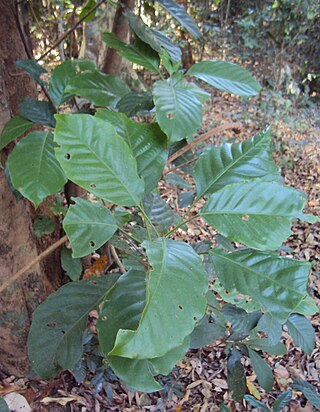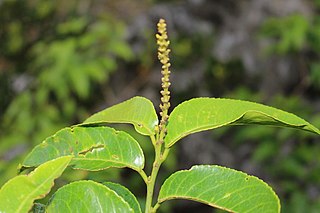
Antidesma is a genus of tropical plant in the family Phyllanthaceae formally described by Linnaeus in 1753. It is native to tropical Africa, S + E + SE Asia, Australia, and various oceanic islands. The greatest diversity occurs in Southeast Asia.

Mallotus is a genus of the spurge family Euphorbiaceae first described as a genus in 1790. Two species are found in tropical Africa and Madagascar, while all others are found in East Asia, the Indian Subcontinent, Southeast Asia, eastern Australia, and certain islands of the western Pacific. The genus has about 150 species of dioecious trees or shrubs.

Sebastiania is a genus of flowering plants in the family Euphorbiaceae first described in 1821. It is native to North and South America from Arizona and the West Indies south to Uruguay.

Macaranga is a large genus of Old World tropical trees of the family Euphorbiaceae and the only genus in the subtribe Macaranginae. Native to Africa, Australasia, Asia and various islands of the Indian and Pacific Oceans, the genus comprises over 300 different species. It was first described as a genus in 1806, based on specimens collected on the Island of Mauritius.

Elateriospermum is a monotypic plant genus in the family Euphorbiaceae. The genus is the only member of tribe Elateriospermeae and contains a single species, Elateriospermum tapos. It is found in Southern Thailand, Peninsular Malaysia, Borneo, Java, and Sumatra. It is known locally as buah perah or perah tree.

Trigonostemon is a plant genus of the family Euphorbiaceae and the sole member of its tribe (Trigonostemoneae). It was first described as a genus in 1826. It is native to Southeast Asia, southern China, the Indian Subcontinent, Queensland, and a few islands in the western Pacific.

Paracroton is a genus of flowering plants in the Euphorbiaceae first described as a genus in 1859. It is native to South and Southeast Asia, as well as New Guinea.
- Paracroton integrifolius(Airy Shaw) N.P.Balakr. & Chakr. - Kerala, Tamil Nadu
- Paracroton pendulus(Hassk.) Miq. - India, Sri Lanka, Myanmar, Thailand, Malaysia, Borneo, Sumatra, Philippines
- Paracroton sterrhopodus(Airy Shaw) Radcl.-Sm. & Govaerts - W New Guinea
- Paracroton zeylanicus(Müll.Arg.) N.P.Balakr. & Chakr. - Sri Lanka

Sphyranthera is a plant genus of the family Euphorbiaceae and the only genus of its tribe (Sphyranthereae). It was first described in 1887. The entire genus is endemic to the Andaman & Nicobar Islands in the Bay of Bengal, politically part of India but geographically closer to Myanmar.
- Sphyranthera airyshawiiChakrab. & Vasudeva Rao - N Andaman Islands
- Sphyranthera lutescens(Kurz) Pax & K.Hoffm. - N Nicobar Islands + C Andaman Islands
Discoclaoxylon is a plant genus of the family Euphorbiaceae, first described in 1914. It is native to western and central Africa, including islands in the Gulf of Guinea.
- Discoclaoxylon hexandrum(Müll.Arg.) Pax & K.Hoffm. - Ghana, Guinea, Ivory Coast, Sierra Leone, Nigeria, Cameroon, Gabon, Central African Republic, Equatorial Guinea, São Tomé, Republic of the Congo, Democratic Republic of the Congo, Uganda
- Discoclaoxylon occidentale(Müll.Arg.) Pax & K.Hoffm. - São Tomé
- Discoclaoxylon pedicellare(Müll.Arg.) Pax & K.Hoffm. - Bioko (Cameroon)
- Discoclaoxylon pubescens(Pax & K.Hoffm.) Exell - Annobón
Lasiococca is a plant genus of the family Euphorbiaceae first described in 1887. These are small to relatively large trees found in scrubs or semi-evergreen forests. They grow in India, Indochina, Southeast Asia, and southern China.
- Lasiococca brevipes(Merr.) Welzen & S.E.C.Sierra - Peninsular Malaysia, Philippines, Lesser Sunda Islands, Sulawesi
- Lasiococca chaniiThin - Vietnam
- Lasiococca comberiHaines - Hainan, Yunnan, Vietnam, Thailand, E India
- Lasiococca lociiThin - Vietnam
- Lasiococca symphylliifolia(Kurz) Hook.f. - Sikkim

Agrostistachys is a plant genus of the family Euphorbiaceae first described as a genus in 1850. It is native to Southeast Asia, New Guinea, India, and Sri Lanka.
- Agrostistachys borneensisBecc. - India, Sri Lanka, Thailand, Vietnam, Malaysia, Borneo, Philippines, Sumatra, New Guinea
- Agrostistachys gaudichaudiiMüll.Arg. - Thailand, Peninsular Malaysia
- Agrostistachys hookeri(Thwaites) Benth. & Hook.f. - Sri Lanka
- Agrostistachys indicaDalzell - India, Sri Lanka, Thailand, Vietnam, Myanmar, Laos, Cambodia, Malaysia, Borneo, Philippines, New Guinea
- Agrostistachys sessilifolia(Kurz) Pax & K.Hoffm. - Peninsular Malaysia, Borneo, Sumatra
- Agrostistachys staminodiataSevilla - Sumatra
Discocleidion is a plant genus of the family Euphorbiaceae first described as a genus in 1914. It contains one accepted species, Discocleidion rufescens, endemic to China.
Neoscortechinia is a plant genus of the family Euphorbiaceae first described as a genus in 1897. It is native to Southeast Asia and Papuasia.
- Neoscortechinia angustifolia(Airy Shaw) Welzen - Sabah, Kalimantan
- Neoscortechinia forbesii(Hook.f.) S.Moore - New Guinea, Admiralty Islands, Bismarck Archipelago, Solomon Islands
- Neoscortechinia kingii(Hook.f.) Pax & K.Hoffm. - W Malaysia, Sumatra, Borneo
- Neoscortechinia nicobarica(Hook.f.) Pax & K.Hoffm. - Nicobar Islands, Myanmar, Malaysia, Indonesia, Philippines, W New Guinea
- Neoscortechinia philippinensis(Merr.) Welzen - Myanmar, Thailand, Malaysia, W Indonesia, Philippines
- Neoscortechinia sumatrensisS.Moore - W Malaysia, N. Sumatra, Simeuluë, Borneo

Epiprinus is a genus of plant of the family Euphorbiaceae first described as a genus in 1854. It is native to Indochina, Sumatra, southern China, and the Indian Subcontinent.
- Epiprinus balansae(Pax & K.Hoffm.) Gagnep. - Vietnam
- Epiprinus lanceifoliusCroizat - Vietnam
- Epiprinus malayanusGriff. - Myanmar, Thailand, Peninsular Malaysia, Sumatra
- Epiprinus mallotiformis(Müll.Arg.) Croizat - southern India
- Epiprinus poilaneiGagnep. - Vietnam
- Epiprinus siletianus(Baill.) Croizat - Hainan, Yunnan, Assam, Laos, Myanmar, Thailand, Vietnam

Shirakiopsis is a genus of flowering plants in the family Euphorbiaceae first described as a genus in 1999. There are six known species, 3 native to tropical Asia and 3 to tropical Africa.

Baccaurea is a genus of flowering plants belonging to the family Phyllanthaceae. The genus comprises 51 species, distributed from India to Indochina, southern China, Malesia, New Guinea, and the West Pacific. It is dioecious, with male and female flowers on separate plants. Many species contain edible fruits.

Breynia is a genus in the flowering plant family Phyllanthaceae, first described in 1776. It is native to Southeast Asia, China, Réunion, the Indian Subcontinent, Papuasia and Australia.

Barringtonia is a genus of flowering plants in the family Lecythidaceae first described as a genus with this name in 1775. It is native to Africa, southern Asia, Australia, and various islands of the Pacific and Indian Oceans. The genus name commemorates Daines Barrington.

Chisocheton is a genus of trees in the family Meliaceae. The genus name comes from the Greek schizos and chiton meaning "split tunic", referring to the lobed staminal tube of C. patens. Their range is from India and tropical China, throughout Malesia and south to New South Wales and Vanuatu.

Diplospora is a genus of flowering plants in the family Rubiaceae. The genus is found in tropical and subtropical Asia.
















